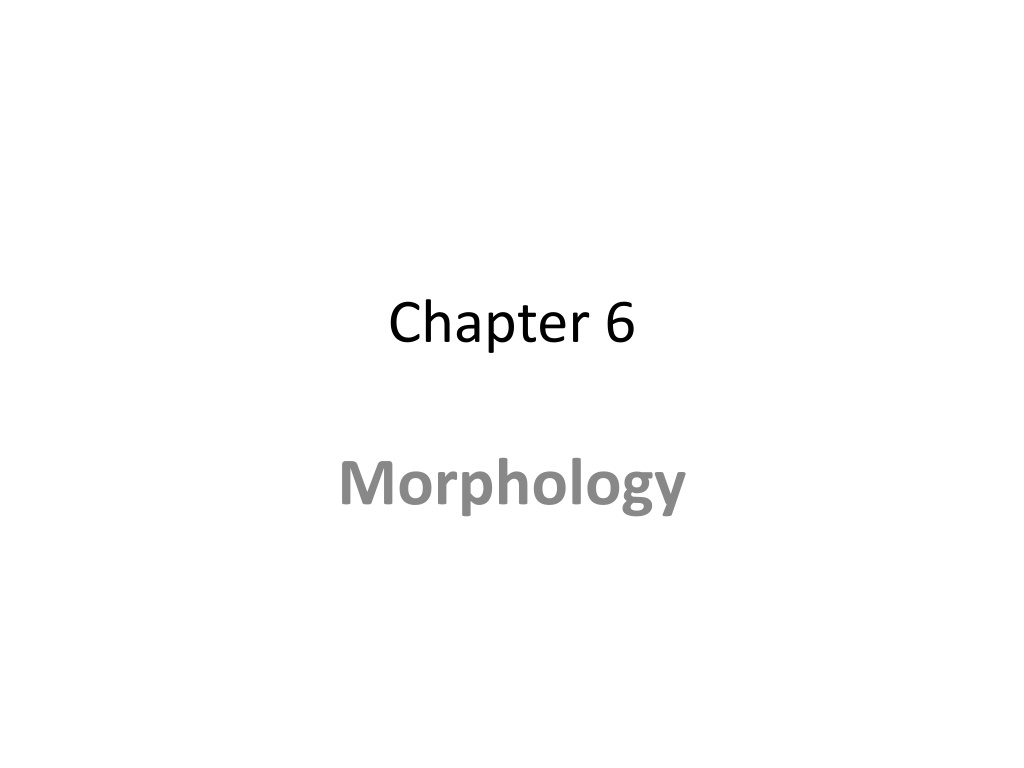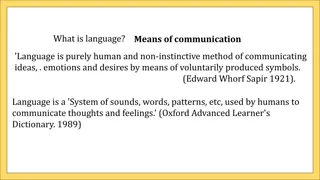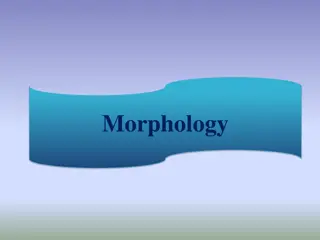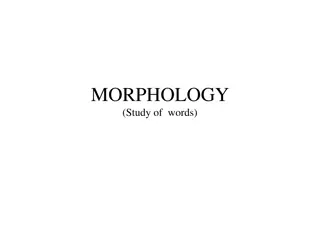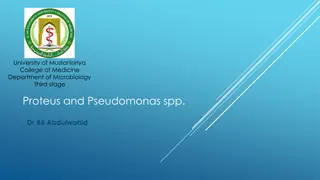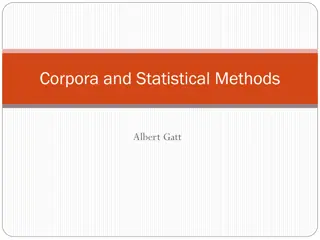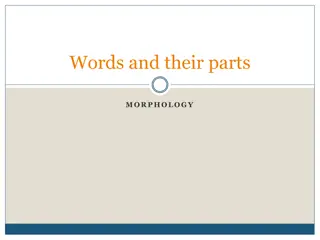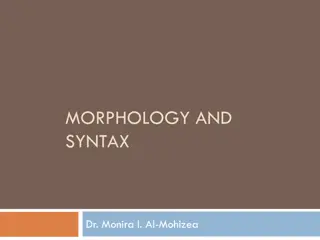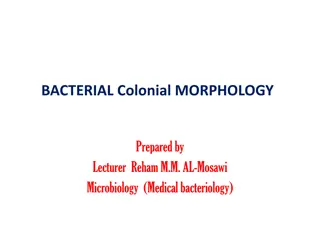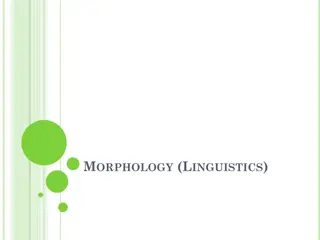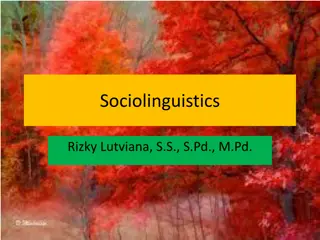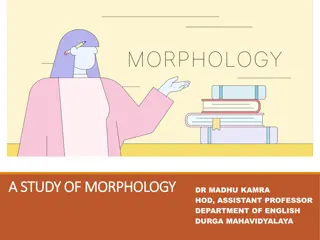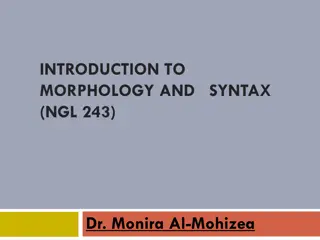Morphology in Language Study
Delve into the study of morphology in linguistics to analyze the basic elements of language, known as morphemes. Discover the differentiation between free and bound morphemes, lexical and functional morphemes, as well as derivational and inflectional morphemes, each playing a crucial role in shaping linguistic messages.
Download Presentation

Please find below an Image/Link to download the presentation.
The content on the website is provided AS IS for your information and personal use only. It may not be sold, licensed, or shared on other websites without obtaining consent from the author.If you encounter any issues during the download, it is possible that the publisher has removed the file from their server.
You are allowed to download the files provided on this website for personal or commercial use, subject to the condition that they are used lawfully. All files are the property of their respective owners.
The content on the website is provided AS IS for your information and personal use only. It may not be sold, licensed, or shared on other websites without obtaining consent from the author.
E N D
Presentation Transcript
Chapter 6 Morphology
Swahili nitakupenda I will love you ni ta ku I will you love penda In order to understand and analyze linguistic messages, Instead of words , let s refer to them as elements also known as morphemes Morphology: the study of forms / a type of investigation that analyzes all those basic elements used in a language.
Morphemes E.g talks, talker, talked, and talking consist of one element talk and a number of other elements such as s, -er,-ed,-ing these are called morphemes Morpheme: A minimal unit of meaning or grammatical function; Units of grammatical function include forms such as past tense or plural E.g., Reopened has 3 morphemes; tourists contains 3 morphemes
Free and bound morphemes Free morphemes morphemes that can stand by themselves as single words, for example open and tour. Bound morphemes they cannot stand alone and are typically attached to another form, re, -ist,-ed,-s (affixes; prefixes and suffixes) Basic word forms are technically known as stems. E.g. dress and care in : undressed, carelessness An exception; words like, receive, reduce and repeat; bound morpheme is re- at the beginning, but the elements ceive,-duce and -peat are not separate word forms an hence cannot be free morphemes called bound stems
Lexical and functional morphemes Free morphemes fall into 2 categories: 1- Lexical morphemes : nouns, adjectives an verbs content of the messages we convey e.g. girl, man, house, long, sincere, open, look, follow, break. Open class of words / we can always add new ones 2- Functional morphemes (e.g. and, but, when, because, on, near, above, in, the, that, it, them) Closed class of words (conjunctions, prepositions, articles and pronouns) new morphemes are never added
Derivational and Inflectional morphemes The set of affixes for bound morphemes are divided in two types: 1- derivational morphemes: we use these bound morphemes to make new words or to make words of a different grammatical category from the stem. -ness changes the adjective good to the noun goodness. The noun care can become the adjectives careful or careless by the addition of the derivational morphemes ful or less So they include both: Suffixes such as the ish in foolish,- ly in quickly, -ment in payment and Prefixes such as re-, pre- , ex-, mis-, co-, un and many more
Cont 2- Inflectional morphemes not used to produce new words, but rather to indicate grammatical function of a word. inflectional morphemes are used to show if a word is plural or singular, if it is past tense or not, and if it is a comparative or possessive form English has only 8 inflectional morphemes E.g pg. 69 In English all the inflectional morphemes are suffixes
Morphological description Some suffixes have two functions, e.g. er: It can be an inflectional morpheme/ never changes the grammatical category of a word. e.g, both old and older are adjectives. The er inflection here simply creates a different version of the adjective. it cam be a derivational morpheme/ can change the grammatical category of a word. The word teach becomes the noun teacher when er is added.
Whenever there is both a derivational and an inflectional suffix attached to the same word, they are always attached in the same order, first the derivational and then the inflectional E.g., teach teach(er)- teacher(s) We can now analyze the elements in any sentence, e.g., The child s wildness shocked the teachers it has 11 morphemes (pg. 70)
Morphs and allomorphs To treat differences in inflectional morphemes linguists have proposed some variation in the morphological descriptions of them. Morphs are the actual forms use to realize morphemes e.g., cats (consists of two morphs cat + -s); also buses (bus + -es) so the 2 different morphs indicating plural (-s and es) can be referred to as allomorphs of the plural morpheme. Another allomorph of plural in English seems to be zero-morph, the plural of sheep is sheep; also the vowel change in some irregular verbs is considered an allomorph of the plural morpheme, e.g., man/ men, so it is an irregular plural form another example of allomorphs of a single morpheme are the allomorphs of the past morpheme E.g., Walk + past tense walked, go + past tense went, an irregular past form
When we look at the morphological processes in other languages we can find a regular pattern that is followed in every language E.g., English and Aztec (follow the same process when attaching a derivational and an inflectional form) Other languages Aztec (72) Kanuri (72-73) Ganda (73) Ilocano (73) Tagalog (74)
